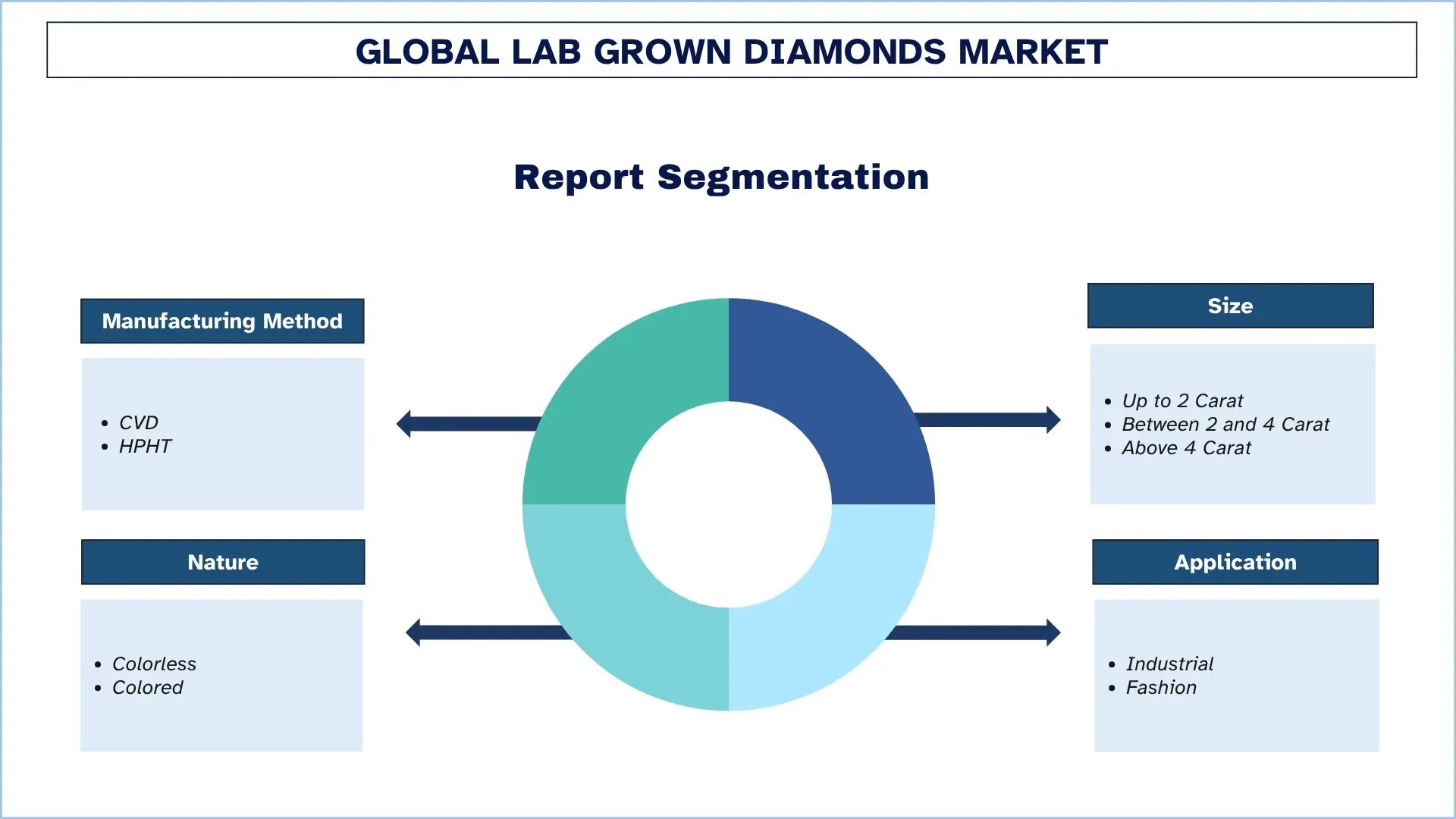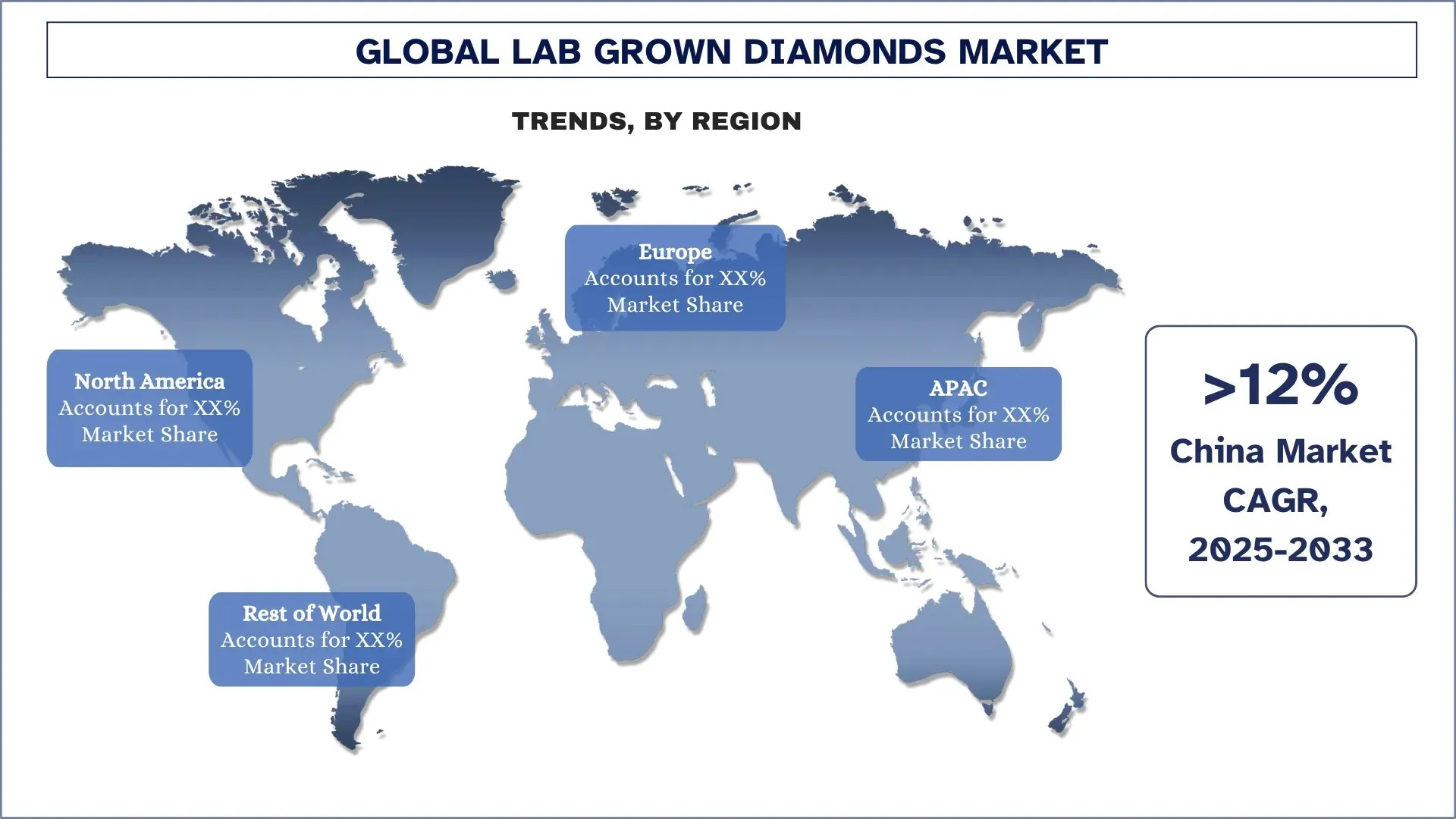- Home
- About Us
- Industry
- Services
- Reading
- Contact Us
Lab Grown Diamonds Market: Current Analysis and Forecast (2025-2033)
Emphasis on Manufacturing Method (CVD and HPHT); Size (Up to 2 Carat, Between 2 and 4 Carat, and Above 4 Carat); Nature (Colorless and Colored); Application (Industrial and Fashion); and Region/Country

Global Lab Grown Diamonds Market Size & Forecast
The Global Lab-Grown Diamonds Market was valued at USD 27.24 billion in 2024 and is expected to grow at a CAGR of around 11.77% during the forecast period (2025-2033F), driven by growing ethical and environmental concerns, cost competitiveness, and changing consumer preferences.
Lab Grown Diamonds Market Analysis
Lab-grown diamonds are being rapidly sold in the global market as more people appreciate their sustainability, ethical sourcing, and affordability. It's essential to note that these lab-grown diamonds are not only similar but also chemically and physically identical to natural diamonds. They are manufactured through an advanced technology process that mimics the natural environment's diamond formation process. This innovation has been driven by the growing awareness of the environmental and ethical reasons behind the style of mining of diamonds; reasons that lead to the ecological destruction and human rights violations that are witnessed with this kind of diamond mining. The increased customer demand for ethical and eco-friendly products, combined with the development of innovative technology for producing diamonds through synthetic procedures, has significantly contributed to the growing demand for lab-grown diamonds. Besides meeting the needs of the jewelry market, these diamonds have also been utilized in industrial processes, where they are highly sought after due to their properties, such as hardness, among others. The consumer shift toward sustainability, combined with the ongoing decline in production costs, is gaining momentum, stimulating the market expansion of lab-grown diamonds. As industries seek to minimize their environmental impact and pursue ethical rectitude, they are becoming eager adopters.
Global Lab-Grown Diamonds Market Trends
This section discusses the key market trends that are influencing the various segments of the global lab-grown diamonds market, as found by our team of research experts.
Rise of Colored Lab-Grown Diamonds
The production of colored lab-grown diamonds has turned into the latest and most unexpected trend in the global diamond market. Though the initial attempts of culturing diamonds in the labs were made to formulate a similar unique sheen of the mined diamond which is usually with a colorless end product, yet with the advancement in technology, many varieties of colorful gemstones, such as pink, blue, yellow, and green diamonds, can now be designed. Such colored diamonds are becoming increasingly in demand among consumers who seek unique, individual, and distinctive pieces of jewelry. Whereas high-quality, natural-colored diamonds are so rare that they cost heavily, laboratory-manufactured ones appear equally precious at a very low price, making them more affordable to a wider audience, as they are equally appealing. The trend is especially alluring to younger consumers who value their individuality, creativity, and an ethical source. Jewel designers are also adopting the change; daring and unconventional colors are making their way to the modern line. For example, in July 2024, Grown Brilliance presented the collection of jewelry called “Melrose” that became the first collection where the newly grown pink and blue diamonds are used. With the consumer demand ever-embracing authenticity in customization and self-expression, we predict the market for colored lab-grown diamonds to rise briskly.

Lab Grown Diamonds Industry Segmentation
This section provides an analysis of the key trends in each segment of the global lab-grown diamonds market report, along with forecasts at the global, regional, and country levels for 2025-2033.
The CVD Market Dominates the Lab-Grown Diamonds Market
Based on manufacturing methods, the lab-grown diamonds market is segmented into CVD and HPHT. In 2024, the CVD segment dominated the market and is expected to maintain its leading position throughout the forecast period. CVD diamonds offer the benefits of purity, quality, and size control, making them well-suited for both complex industrial applications and fine jewelry. CVD diamonds are used in electronics, optical products, and cutting tools. The CVD method is also energy-intensive, but less harsh to the environment compared to the traditional mining method, which explains why it resonates well with the international campaign to find a sustainable alternative. The CVD diamond market is experiencing increased demand due to a shift in consumer and industrial focus towards the need to purchase and process in an ethical and environmentally friendly manner. Additionally, the improvement of synthesis technology is reducing production costs and, in turn, providing better quality, thereby encouraging its further use across all sectors. The trend towards green, carbon-neutral materials accelerates the process of innovation in synthetic gemstone production, and lab-grown diamonds have become one of the most promising materials in both sustainable luxury commodities and next-generation technologies.
The Up to 2 Carat Category held the Largest Market Share in the Lab Grown Diamonds Market
Based on size, the lab-grown diamond market is segmented into up to 2 Carats, between 2 and 4 Carats, and above 4 Carats. The up to 2 carat category held the largest market share in 2024. The primary driver of segmental growth is the increasing demand for affordable, everyday accessories that align with ethical sourcing and sustainability principles. The types of diamonds produced in this process are particularly in demand for engagement rings, earrings, and pendants because they are less expensive in terms of price compared to mined ones, yet are equally attractive and sparkly. These diamonds are also making inroads due to the efforts of cutting and polishing techniques that make them more appealing to look at and cannot be distinguished from mined ones. Diamonds of lower carats remain ever popular because they are affordable, versatile in fashion styles, and in touch with the current trends of minimalism, which have solidified as the most influential segment in the market.
Asia Pacific Dominated the Global Lab-Grown Diamonds Market
The largest market for lab-grown diamonds is the Asia-Pacific region and is projected to dominate the market throughout the forecast period. One of the significant factors that have placed the area at the forefront of the lab-grown diamond industry is rapid urbanization, an expanding population of the middle and upper classes, and a rise in awareness of sustainable and ethical consumption. Some of the countries that have become significant in both the production and consumption of lab-grown diamonds include China, India, and Singapore. India, specifically, is at the forefront of this process, as its diamond cutting and polishing sector is extremely well-established, and its domestic demand for discount and sustainable luxury is also growing. Due to technological improvements in HPHT and CVD production processes, as well as government economic support for green firms' manufacturing techniques, China has become a force to reckon with in the production of lab-grown diamonds. Along with that, the consumer trend, as well as industrial innovation, regarding the hardness of lab-grown diamonds, their thermal conductivity, and electricity, is also increasing the demand in the fashion world and industry to serve the known region. The perception of environmental awareness and sustainability in the Asia-Pacific market segments has increased the popularity of lab-grown diamonds over mined diamonds, as the area takes the lead in this emerging market.
China held a dominant Share of the Asia Pacific Lab Grown Diamonds Market in 2024
China dominates the market of lab-grown diamonds in the Asia-Pacific region. The country's success is attributed to its quality factories, relentless technological development, and strong domestic demand. China is a world leader in the production of synthetic diamonds, having made significant investments in both CVD and HPHT technologies. Diamond manufacturers based in China do export to dealers in the Asian region and other parts of the world. They ensure prices remain low and have access to an industry that is fully developed in the processing of gemstones. Many more Chinese customers, particularly the younger ones, are willing to pay for sustainable and ethically produced products. This is compelling increasing numbers of jewelry manufacturers to resort to lab-grown diamonds. China also provides a considerable number of low-carbon industrial-quality diamonds to electronics, cutting implements, and other high-tech applications, making it a predominant player in the lab-grown diamond market worldwide.

Lab Grown Diamonds Industry Competitive Landscape
The global lab-grown diamonds market is competitive, with several global and international market players. The key players are adopting different growth strategies to enhance their market presence, such as partnerships, agreements, collaborations, new product launches, geographical expansions, and mergers and acquisitions.
Top Lab Grown Diamonds Companies
Some of the major players in the market are Mini Diamonds (I) Ltd., WD Advanced Materials, LLC, De Beers Group, ADAMAS ONE, Solitario, Henan Huanghe Whirlwind CO., Ltd., Swarovski AG, ABD Diamonds, New Diamond Technology LLC, and Mittal Diamonds.
Recent Developments in the Lab-Grown Diamonds Market
In October 2024, Trent, a TATA subsidiary, launched the lab-grown diamond brand Prome in Westside stores to cater to its value-conscious customers with competitively priced jewelry, tapping into the rising demand for sustainable, affordable diamonds.
In August 2024, Mini Diamonds, an India-based diamond and jewelry brand, unveiled its laboratory-grown diamond jewelry shop in South Mumbai, India, through its subsidiary, Namra Jewels.
In August 2024, a Canadian jewelry company, Parasamani Inc., collaborated with Mini Diamonds, which is a jewelry and diamond brand in India. Parasamani marketed the lab-grown diamond jewelry made by Mini Diamond all over Canada.
Global Lab Grown Diamonds Market Report Coverage
Details | |
Base year | 2024 |
Forecast period | 2025-2033 |
Growth momentum | Accelerate at a CAGR of 11.77% |
Market size 2024 | USD 27.24 Billion |
Regional analysis | North America, Europe, APAC, Rest of the World |
Major contributing region | Asia Pacific is expected to dominate the market during the forecast period. |
Key countries covered | U.S., Canada, Germany, U.K., Spain, Italy, France, China, Japan, India, and South Korea |
Companies profiled | Mini Diamonds (I) Ltd., WD Advanced Materials, LLC, De Beers Group, ADAMAS ONE, Solitario, Henan Huanghe Whirlwind CO.,Ltd., Swarovski AG, ABD Diamonds, New Diamond Technology LLC, and Mittal Diamonds |
Report Scope | Market Trends, Drivers, and Restraints; Revenue Estimation and Forecast; Segmentation Analysis; Demand and Supply Side Analysis; Competitive Landscape; Company Profiling |
Segments Covered | By Manufacturing Method; By Size; By Nature; By Application; By Region/Country |
Reasons to Buy Lab Grown Diamonds Market Report:
The study includes market sizing and forecasting analysis confirmed by authenticated key industry experts.
The report briefly reviews overall industry performance at a glance.
The report covers an in-depth analysis of prominent industry peers, primarily focusing on key business financials, type portfolios, expansion strategies, and recent developments.
Detailed examination of drivers, restraints, key trends, and opportunities prevailing in the industry.
The study comprehensively covers the market across different segments.
Deep dive regional-level analysis of the industry.
Customization Options:
The global lab-grown diamonds market can further be customized as per the requirements or any other market segment. Besides this, UnivDatos understands that you may have your own business needs; hence, feel free to contact us to get a report that completely suits your requirements.
Table of Content
Research Methodology for the Global Lab Grown Diamonds Market Analysis (2023-2033)
We analyzed the historical market, estimated the current market, and forecasted the future market of the global lab-grown diamonds market to assess its application in major regions worldwide. We conducted exhaustive secondary research to gather historical market data and estimate the current market size. To validate these insights, we carefully reviewed numerous findings and assumptions. Additionally, we conducted in-depth primary interviews with industry experts across the lab-grown diamonds value chain. After validating market figures through these interviews, we used both top-down and bottom-up approaches to forecast the overall market size. We then employed market breakdown and data triangulation methods to estimate and analyze the market size of industry segments and sub-segments.
Market Engineering
We employed the data triangulation technique to finalize the overall market estimation and derive precise statistical numbers for each segment and sub-segment of the global lab-grown diamonds market. We split the data into several segments and sub-segments by analyzing various parameters and trends, including manufacturing method, size, nature, application, and regions within the global lab-grown diamonds market.
The Main Objective of the Global Lab-Grown Diamonds Market Study
The study identifies current and future trends in the global lab-grown diamonds market, providing strategic insights for investors. It highlights regional market attractiveness, enabling industry participants to tap into untapped markets and gain a first-mover advantage. Other quantitative goals of the studies include:
Market Size Analysis: Assess the current market size and forecast the market size of the global lab-grown diamonds market and its segments in terms of value (USD).
Lab Grown Diamonds Market Segmentation: Segments in the study include areas of manufacturing method, size, nature, application, and regions.
Regulatory Framework & Value Chain Analysis: Examine the regulatory framework, value chain, customer behavior, and competitive landscape of the lab-grown diamonds industry.
Regional Analysis: Conduct a detailed regional analysis for key areas such as Asia Pacific, Europe, North America, and the Rest of the World.
Company Profiles & Growth Strategies: Company profiles of the lab-grown diamonds market and the growth strategies adopted by the market players to sustain the fast-growing market.
Frequently Asked Questions FAQs
Q1: What is the global lab-grown diamonds current market size and its growth potential?
The global lab-grown diamonds market was valued at USD 27.24 billion in 2024 and is expected to grow at a CAGR of 11.77% during the forecast period (2025-2033).
Q2: Which segment has the largest share of the global lab-grown diamonds market by manufacturing method?
The CVD segment dominated the market and is expected to maintain its leading position throughout the forecast period. CVD diamonds have the advantage of control of purity, quality, and size, and are particularly suited to fine jewelry as well as sophisticated industrial markets.
Q3: What are the driving factors for the growth of the global lab-grown diamonds market?
• Ethical and Environmental Concerns: Lab-grown diamonds provide a sustainable, conflict-free alternative to mined diamonds, reducing environmental harm and addressing ethical concerns linked to traditional diamond mining.
• Cost Competitiveness: Lab-grown diamonds are more affordable than natural diamonds, offering identical quality at lower prices, making luxury jewelry accessible to a broader consumer market.
• Changing Consumer Preferences: Consumers, especially younger generations, prefer ethical, sustainable, and customizable products, driving the shift toward lab-grown diamonds that align with modern lifestyle values.
Q4: What are the emerging technologies and trends in the global lab-grown diamonds market?
• Rise of Colored Lab-Grown Diamonds: Advancements in technology enable the creation of vibrant colored diamonds, appealing to consumers seeking unique, fashionable, and affordable alternatives to rare natural-colored stones.
• Shift Toward Customization and Personalization: Consumers increasingly desire personalized, meaningful jewelry. Lab-grown diamonds allow greater design flexibility, enabling unique creations that reflect individual style, values, and self-expression.
Q5: What are the key challenges in the global lab-grown diamonds market?
• Rapid Price Erosion and Poor Resale Value: Lab-grown diamonds face declining prices and weak resale value, which can deter traditional buyers who view diamonds as long-term investments or assets.
• High Energy Consumption and Environmental Concerns: Despite being more sustainable than mining, lab-grown diamond production, especially HPHT, remains energy-intensive, raising concerns about its true environmental impact and carbon footprint.
Q6: Which region dominates the global lab-grown diamonds market?
Asia-Pacific is the biggest market for lab-grown diamonds and is likely to lead the market even in the forecast period. The key factors driving the growth of the region in the lab-grown diamond industry are rapid urbanization, a growing middle- and upper-class population, and rising awareness of sustainability and ethical consumption.
Q7: Who are the key players in the global lab-grown diamonds market?
Some of the major lab-grown diamond companies include:
• Mini Diamonds (I) Ltd.
• WD Advanced Materials, LLC
• De Beers Group
• ADAMAS ONE
• Solitario
• Henan Huanghe Whirlwind CO., Ltd.
• Swarovski AG
• ABD Diamonds
• New Diamond Technology LLC
• Mittal Diamonds
Q8: What is the current regulatory landscape for the lab-grown diamonds market, and how does it impact business operations?
• Strengthening Certification Standards: Regulatory bodies are introducing stricter certification and grading standards for lab-grown diamonds to ensure transparency and consumer trust, supporting long-term market credibility.
• Customs and Tax Incentives: Many governments, including India’s, have reduced duties on diamond seeds and permitted 100% FDI, making operations more favorable for global investors.
• Environmental Compliance: Growing environmental regulations push manufacturers to adopt greener production processes, creating both compliance challenges and differentiation opportunities for eco-conscious investors.
Q9: How does the scalability of production affect investment potential in the lab-grown diamonds market?
• Economies of Scale Lower Costs: Larger production volumes reduce per-carat costs, improving profitability and competitiveness in both jewelry and industrial markets.
• Technology-Driven Scalability: Adoption of automated and energy-efficient growth methods enables faster scaling without compromising quality.
• Market Leadership Potential: Scalable operations position companies to dominate emerging markets, making them attractive to investors seeking high-growth opportunities.
Related Reports
Customers who bought this item also bought










